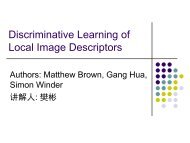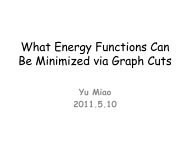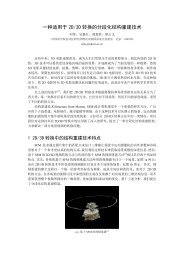A fast local descriptor for dense matching - Robot Vision Group
A fast local descriptor for dense matching - Robot Vision Group
A fast local descriptor for dense matching - Robot Vision Group
Create successful ePaper yourself
Turn your PDF publications into a flip-book with our unique Google optimized e-Paper software.
<strong>Vision</strong>-Based Odometry and SLAM <strong>for</strong><br />
Medium and High Altitude Flying UAVs<br />
J Intell <strong>Robot</strong> Syst 2009<br />
F.Caballero L.Merino J.Ferruz A.Ollero<br />
University of Seville
Odometry<br />
odometry is composed from the Greek words hodos (meaning<br />
"travel", "journey") and metron (meaning "measure").<br />
Odometry is the use of data from the movement of actuators to<br />
estimate change in position over time.
Introduction<br />
Describing a monocular visual odometer which could be used as a<br />
backup system when the accuracy of GPS is reduced to critical<br />
levels.<br />
Integrating the visual odometer into a SLAM scheme in order to<br />
reduce the impact of cumulative errors in odometry-based position<br />
estimation approaches.
Homography-Based Visual Odometry <strong>for</strong> UAVs<br />
Robust Homography Estimation<br />
The algorithm <strong>for</strong> homography computation basically consists of a<br />
point-feature tracker that obtains matches between images, and a<br />
combination of least median of squares and M-Estimator <strong>for</strong> outlier<br />
rejection and accurate homography estimation from these matches.<br />
Two Problems:<br />
non-uni<strong>for</strong>m distribution of the features along the images<br />
the parallax effect will increase, and the planarity assumption will<br />
not hold
Homography-Based Visual Odometry <strong>for</strong> UAVs<br />
Robust Homography Estimation<br />
Complete homography. Least median of squares (LMedS) is used <strong>for</strong><br />
outlier rejection and a M-Estimator to compute the final result. This<br />
model is used if more than the 65% of the matches are successfully<br />
tracked.<br />
Affine homography. If the percentage of success in the tracking step<br />
is between 40% and 65%, then the LMedS is not used, given the<br />
reduction in the number of matches. A relaxed M-Estimator (soft<br />
penalization) is carried out to compute the model.<br />
Euclidean homography. If the percentage is below 40%, the set of<br />
data is too noisy and small to apply non-linear minimizations. The<br />
model is computed using least-squares.
Homography-Based Visual Odometry <strong>for</strong> UAVs<br />
Geometry of Two Views of the same Plane
Homography-Based Visual Odometry <strong>for</strong> UAVs<br />
Motion Estimation from Homography
Homography-Based Visual Odometry <strong>for</strong> UAVs<br />
Motion Estimation from Homography<br />
where
Homography-Based Visual Odometry <strong>for</strong> UAVs<br />
Correct Solution Disambiguation<br />
1. The distance among and the rest normal in S n is computed.<br />
2. is set to an initial value.<br />
3. For the current value ,check if there exist an unique solution.<br />
4. If no solution is found, increase the value of and try again with<br />
the step 3. If multiple solutions were found decrease and try<br />
again with step 3. If an unique solution was found, then finish.
Homography-Based Visual Odometry <strong>for</strong> UAVs<br />
An Estimation of the Uncertainties
Homography-Based Visual Odometry <strong>for</strong> UAVs<br />
Experimental Results<br />
Sensors:<br />
DGPS<br />
IMU<br />
Camera
Homography-Based Visual Odometry <strong>for</strong> UAVs<br />
Experimental Results<br />
<strong>Vision</strong>-based technique VS DGPS
Homography-Based Visual Odometry <strong>for</strong> UAVs<br />
Experimental Results<br />
<strong>Vision</strong>-based technique VS DGPS
Homography-Based Visual Odometry <strong>for</strong> UAVs<br />
Experimental Results<br />
<strong>Vision</strong>-based technique VS IMU
Homography-Based Visual Odometry <strong>for</strong> UAVs<br />
Experimental Results<br />
<strong>Vision</strong>-based technique VS IMU
Application of Homography-Based Odometry to the<br />
SLAM Problem<br />
The State Vector<br />
Measurement Vector
Application of Homography-Based Odometry to the<br />
SLAM Problem<br />
Prediction Stage<br />
Updating Stage
Application of Homography-Based Odometry to the<br />
SLAM Problem<br />
Filter and Landmarks Initialization
Application of Homography-Based Odometry to the<br />
SLAM Problem<br />
Experimental Results<br />
SLAM VS DGPS
Application of Homography-Based Odometry to the<br />
SLAM Problem<br />
Experimental Results<br />
SLAM VS DGPS
Application of Homography-Based Odometry to the<br />
SLAM Problem<br />
Experimental Results<br />
SLAM VS DGPS SLAM&IMU VS DGPS


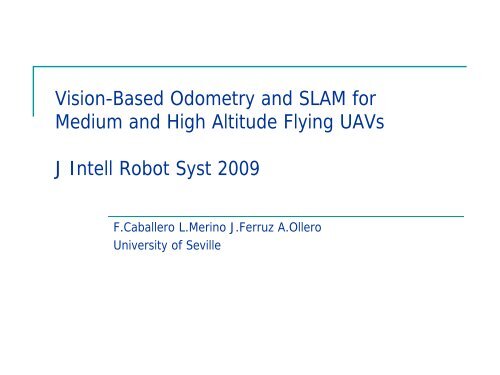
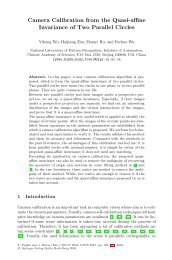
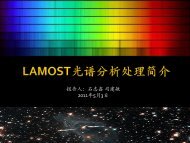
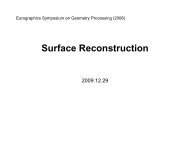
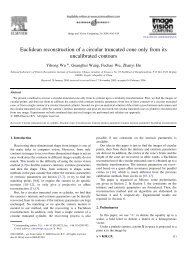
![Accurate, Dense, and Robust Multi-View Stereopsis (PMVS) [1,2,3]](https://img.yumpu.com/19388840/1/190x135/accurate-dense-and-robust-multi-view-stereopsis-pmvs-123.jpg?quality=85)
